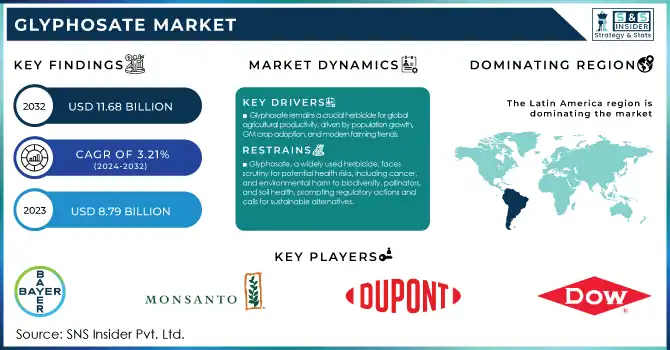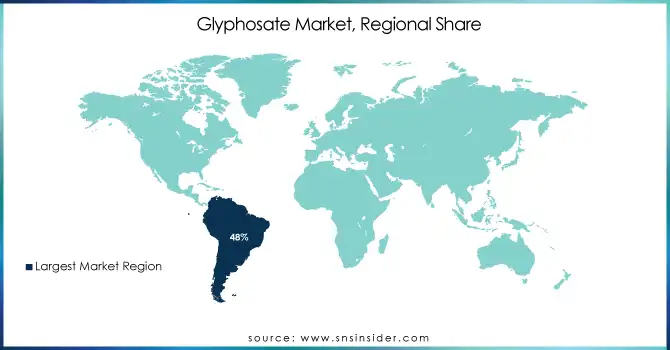Glyphosate Market Report Scope & Overview:
The Glyphosate Market size was valued at USD 8.79 billion in 2023. It is estimated to hit USD 11.68 billion by 2032 and grow at a CAGR of 3.21% over the forecast period of 2024-2032.

Get PDF Sample Report on Glyphosate Market - Request Sample Report
Glyphosate, a widely used herbicide, plays a crucial role in modern agriculture due to its effectiveness in controlling weeds and enhancing crop yields. The market for glyphosate has seen significant growth driven by increasing global demand for high agricultural productivity and the expansion of genetically modified (GM) crops. Farmers worldwide rely on glyphosate for its ability to manage weeds effectively, particularly in row crops like corn, soybeans, and cotton.
The market's growth is also fueled by advancements in agricultural technologies, including herbicide-tolerant GM seeds, which complement glyphosate use. This trend has strengthened the adoption of glyphosate-based herbicides as a preferred solution for sustainable farming practices. However, regulatory scrutiny and environmental concerns related to glyphosate's impact on biodiversity and human health have influenced market dynamics. These concerns have spurred research into alternative herbicides and bio-based solutions, potentially shaping the future of the industry. In terms of market trends, there is a growing shift towards integrated weed management practices that combine chemical, mechanical, and biological approaches. Additionally, the rise in precision farming techniques has driven demand for more efficient and targeted glyphosate applications, reducing overall herbicide usage. Innovations in glyphosate formulations, such as extended residual control and reduced environmental impact, further underscore the market's evolution.
According to research that glyphosate remains one of the most extensively used herbicides globally, with over 70% of GM crops being glyphosate-resistant. The agricultural sector accounts for approximately 80% of glyphosate consumption, while the remaining usage spans industrial and residential applications. Despite challenges, glyphosate's indispensable role in modern farming ensures its continued relevance, while evolving consumer preferences and regulatory landscapes will shape its trajectory. The industry's focus on sustainability and innovation is likely to drive future developments in the glyphosate market.
MARKET DYNAMICS
DRIVERS
- Glyphosate remains a crucial herbicide for global agricultural productivity, driven by population growth, GM crop adoption, and modern farming trends.
The growing global population has significantly increased the demand for agricultural productivity, making glyphosate an essential tool for modern farming. Its ability to effectively control a broad spectrum of weeds ensures healthier crops and maximizes yield, addressing the need for efficient food production. This demand is further amplified by the adoption of genetically modified (GM) crops, designed to be glyphosate-resistant, particularly in major agricultural markets like the U.S., Brazil, and Argentina. Additionally, trends such as precision farming and integrated weed management practices are driving the adoption of glyphosate for its cost-effectiveness and reliability. Despite regulatory scrutiny, the market is witnessing steady growth, supported by emerging economies adopting advanced agricultural practices. However, challenges such as herbicide resistance and environmental concerns are prompting research into improved formulations and sustainable alternatives, ensuring glyphosate's continued relevance in the evolving agricultural landscape.
RESTRAINT
- Glyphosate, a widely used herbicide, faces scrutiny for potential health risks, including cancer, and environmental harm to biodiversity, pollinators, and soil health, prompting regulatory actions and calls for sustainable alternatives.
Glyphosate, a widely used herbicide, has faced growing scrutiny due to its potential health and environmental impacts. The World Health Organization's International Agency for Research on Cancer classified it as "probably carcinogenic to humans," fueling debates about its safety. Beyond human health, glyphosate has been criticized for its environmental consequences. It can negatively affect biodiversity by harming non-target plants and animals, including essential pollinators like bees. Prolonged use also degrades soil health, reducing its fertility and resilience. These concerns have prompted regulatory bodies worldwide to reassess its usage, with some countries imposing bans or restrictions. Additionally, consumers are increasingly demanding alternatives, pushing industries toward more sustainable agricultural practices. The combination of health risks and ecological harm has placed glyphosate at the center of debates on environmental safety and sustainable farming.
MARKET SEGMENTATION
By Application
The agricultural segment dominated with the market share over 83% in 2023, due to its widespread use in crop production. It plays a crucial role in weed management for grains & cereals such as wheat, corn, and rice. Glyphosate is also heavily used in the cultivation of oilseeds & pulses, including soybeans, canola, and sunflowers, along with pulses like lentils and peas. While its application in fruits & vegetables is less prevalent, it still contributes to weed control in these sectors. The others category encompasses additional agricultural uses across various crops, further cementing Glyphosate’s importance in modern farming practices.
By Crop Type
The GM crops segment dominated with the market share over 62% in 2023, due to their genetic modification, which allows them to withstand herbicides like glyphosate. This unique trait makes GM crops the primary users of glyphosate, contributing to their dominance. The widespread adoption of genetically modified crops, particularly in regions such as North America, South America, and parts of Europe, has significantly boosted glyphosate consumption. The ease of use and effectiveness of glyphosate in controlling weeds in GM crops have further solidified its role in modern agriculture, leading to a steady demand for the herbicide in these genetically engineered crops worldwide.
KEY REGIONAL ANALYSIS
Latin America region dominated with the market share over 48% in 2023, due to its extensive agricultural production, particularly in Brazil and Argentina. These countries are major exporters of key crops such as soybeans, corn, and wheat, where glyphosate plays a crucial role in crop protection. Glyphosate is widely used in these nations to control weeds, improve yields, and facilitate the adoption of no-till farming practices, which preserve soil health and reduce labor costs. In Brazil, for instance, glyphosate is essential for the large-scale production of genetically modified crops, such as glyphosate-resistant soybeans, which have further increased the demand for this herbicide.
The Asia-Pacific region is experiencing the fastest growth in the Glyphosate market, driven by a surge in agricultural demand and modern farming practices. Countries like China, India, and several Southeast Asian nations are expanding their agricultural sectors to meet the needs of growing populations. This region’s emphasis on food security, along with the push for higher crop yields, has led to increased herbicide usage, including glyphosate. The adoption of genetically modified (GM) crops, particularly those resistant to glyphosate, has further boosted its demand, as these crops offer better resistance to weeds and improved productivity.

Get Customized Report as per Your Business Requirement - Request For Customized Report
Some of the major key players of the Glyphosate Market
- Bayer AG(Roundup)
- Monsanto (Roundup, Ranger Pro)
- DuPont (Imidazolinone, Pursuit)
- The Dow Chemical Company (Durango, Cleanwave)
- Nufarm Limited (Nufarm Glyphosate, Weedmaster)
- Syngenta Crop Protection (Touchdown, Glyfos)
- ADAMA Agricultural Solutions Limited (Glyphosate 360, Glyphosate 480)
- UPL Limited (Herbicide 500, UPL Glyphosate)
- Nantong Jiangshan Agrochemical & Chemicals Limited Liability Co. (Glystar)
- Corteva Agriscience (Rezilon, Enlist One)
- American Vanguard Corporation (Intrepid, Parazone)
- Sumitomo Chemical (Clearfield)
- Helm AG (Helm Agrochemicals Glyphosate)
- Arysta LifeScience (Arezzo, Gallant)
- Hubei Sanonda Co. Ltd. (Sanonda Glyphosate)
- Lianhetech (Glyphosate)
- BASF SE (Glufosinate, Liberty)
- Sichuan Shengda Agrochemical Co. (Shengda Glyphosate)
- Kumiai Chemical Industry Co., Ltd. (Kumiai Glyphosate)
- Hunan Haili Chemical Industry Co., Ltd. (Haili Glyphosate)
Suppliers for (Known for high-volume production and strong export capabilities, providing cost-effective glyphosate products) on Glyphosate Market
- Bayer CropScience AG (Germany)
- BASF SE (Germany)
- Syngenta AG (Switzerland)
- Corteva Agriscience (USA)
- Wynca Group (China)
- Nufarm Chemical Shanghai Co. Ltd. (China)
- Sichuan Leshan Fuhua Tongda Agro Chemical Technology Co. Ltd. (China)
- Zhejiang Xinan Chemical Industrial Group Co. Ltd. (China)
- Shandong Weifang Rainbow Chemical Co. Ltd. (China)
- Sumitomo Chemical India Ltd. (India)
RECENT DEVELOPMENT
In August 12, 2024: BASF has broadened its InVigor canola lineup by introducing two new hybrid varieties, providing farmers with increased flexibility in crop management. These varieties feature improved yield potential, glyphosate resistance, and enhanced weed control through the use of Liberty glufosinate-ammonium herbicide, helping to combat herbicide resistance issues.
In March 2023: Albaugh, LLC acquired Corteva Agriscience's glyphosate business, which includes intangible assets such as formulations, trade names, regulatory data, registrations, patents, and know-how used globally in Corteva's straight-goods glyphosate operations, excluding Argentina.
In February 2023: Corteva introduced Optimum GLY canola, an advanced herbicide-tolerant trait technology designed for canola farmers. This new proprietary glyphosate trait technology offers improved weed control and extends the herbicide application window compared to earlier generations of glyphosate trait technology.
| Report Attributes | Details |
| Market Size in 2023 | USD 8.79 Billion |
| Market Size by 2032 | USD 11.68 Billion |
| CAGR | CAGR of 3.21% From 2024 to 2032 |
| Base Year | 2023 |
| Forecast Period | 2024-2032 |
| Historical Data | 2020-2022 |
| Report Scope & Coverage | Market Size, Segments Analysis, Competitive Landscape, Regional Analysis, DROC & SWOT Analysis, Forecast Outlook |
| Key Segments | • By Crop Type (Conventional Crops and Genetically Modified Crops) • By Form (Liquid and Dry) • By Application (Agriculture and Non-Agriculture) |
| Regional Analysis/Coverage | North America (US, Canada, Mexico), Europe (Eastern Europe [Poland, Romania, Hungary, Turkey, Rest of Eastern Europe] Western Europe] Germany, France, UK, Italy, Spain, Netherlands, Switzerland, Austria, Rest of Western Europe]), Asia Pacific (China, India, Japan, South Korea, Vietnam, Singapore, Australia, Rest of Asia Pacific), Middle East & Africa (Middle East [UAE, Egypt, Saudi Arabia, Qatar, Rest of Middle East], Africa [Nigeria, South Africa, Rest of Africa], Latin America (Brazil, Argentina, Colombia, Rest of Latin America) |
| Company Profiles | Bayer AG, Monsanto, DuPont, The Dow Chemical Company, Nufarm Limited, Syngenta Crop Protection, ADAMA Agricultural Solutions Limited, UPL Limited, Nantong Jiangshan Agrochemical & Chemicals Limited Liability Co., Corteva Agriscience, American Vanguard Corporation, Sumitomo Chemical, Helm AG, Arysta LifeScience, Hubei Sanonda Co. Ltd., Lianhetech, BASF SE, Sichuan Shengda Agrochemical Co., Kumiai Chemical Industry Co., Ltd., and Hunan Haili Chemical Industry Co., Ltd. |
| Key Drivers | • Glyphosate remains a crucial herbicide for global agricultural productivity, driven by population growth, GM crop adoption, and modern farming trends. |
| RESTRAINTS | • Glyphosate, a widely used herbicide, faces scrutiny for potential health risks, including cancer, and environmental harm to biodiversity, pollinators, and soil health, prompting regulatory actions and calls for sustainable alternatives. |

